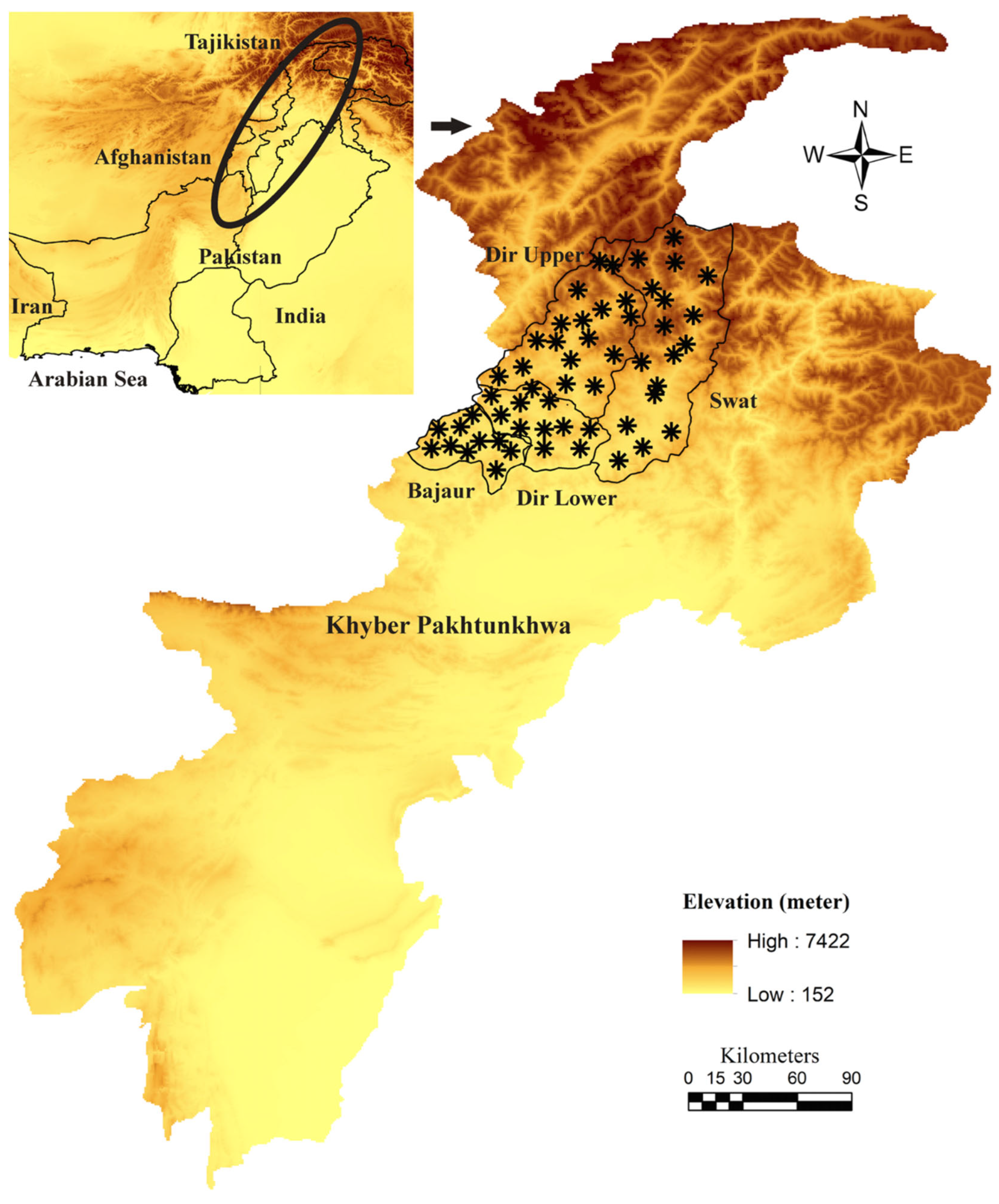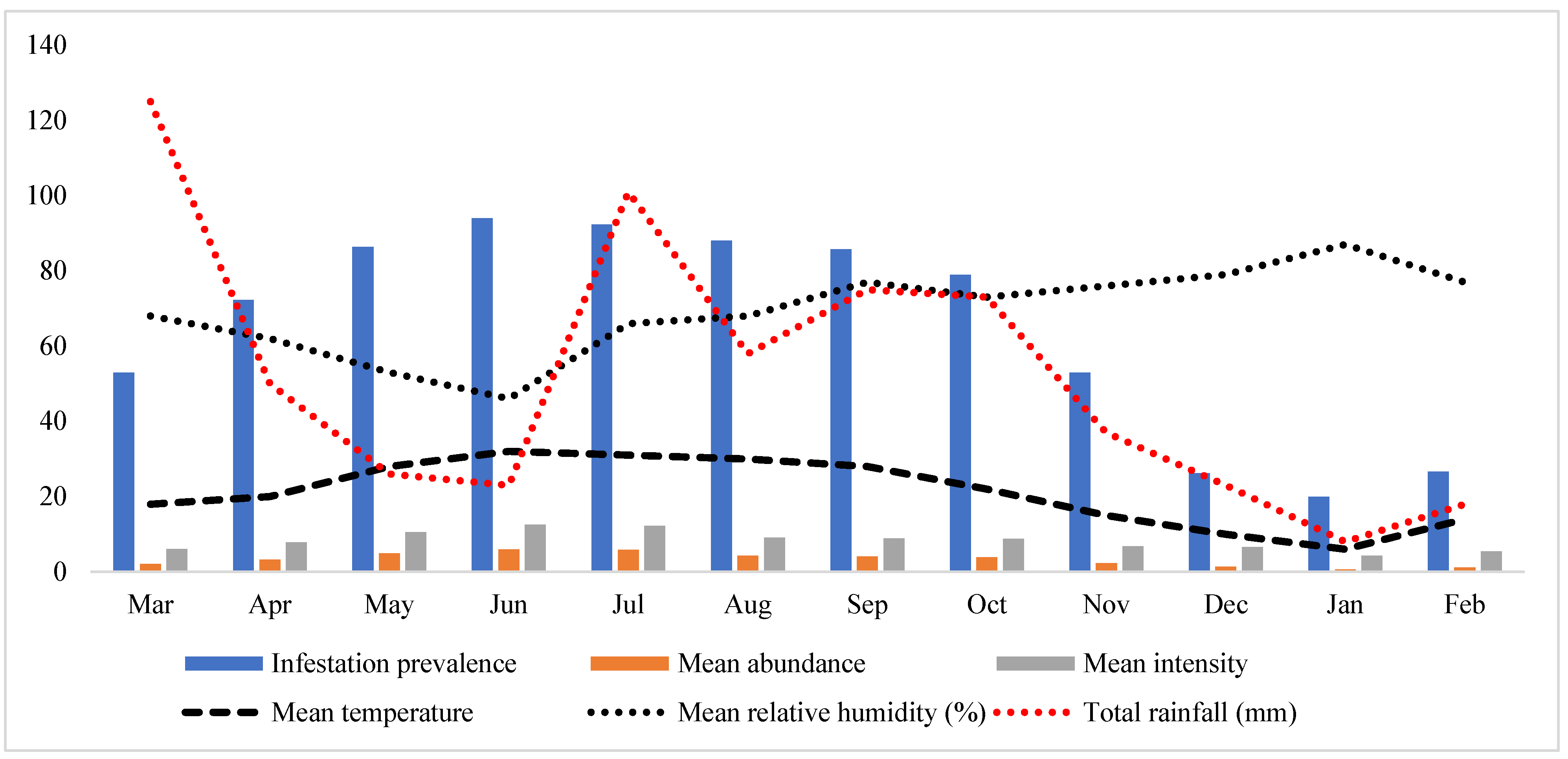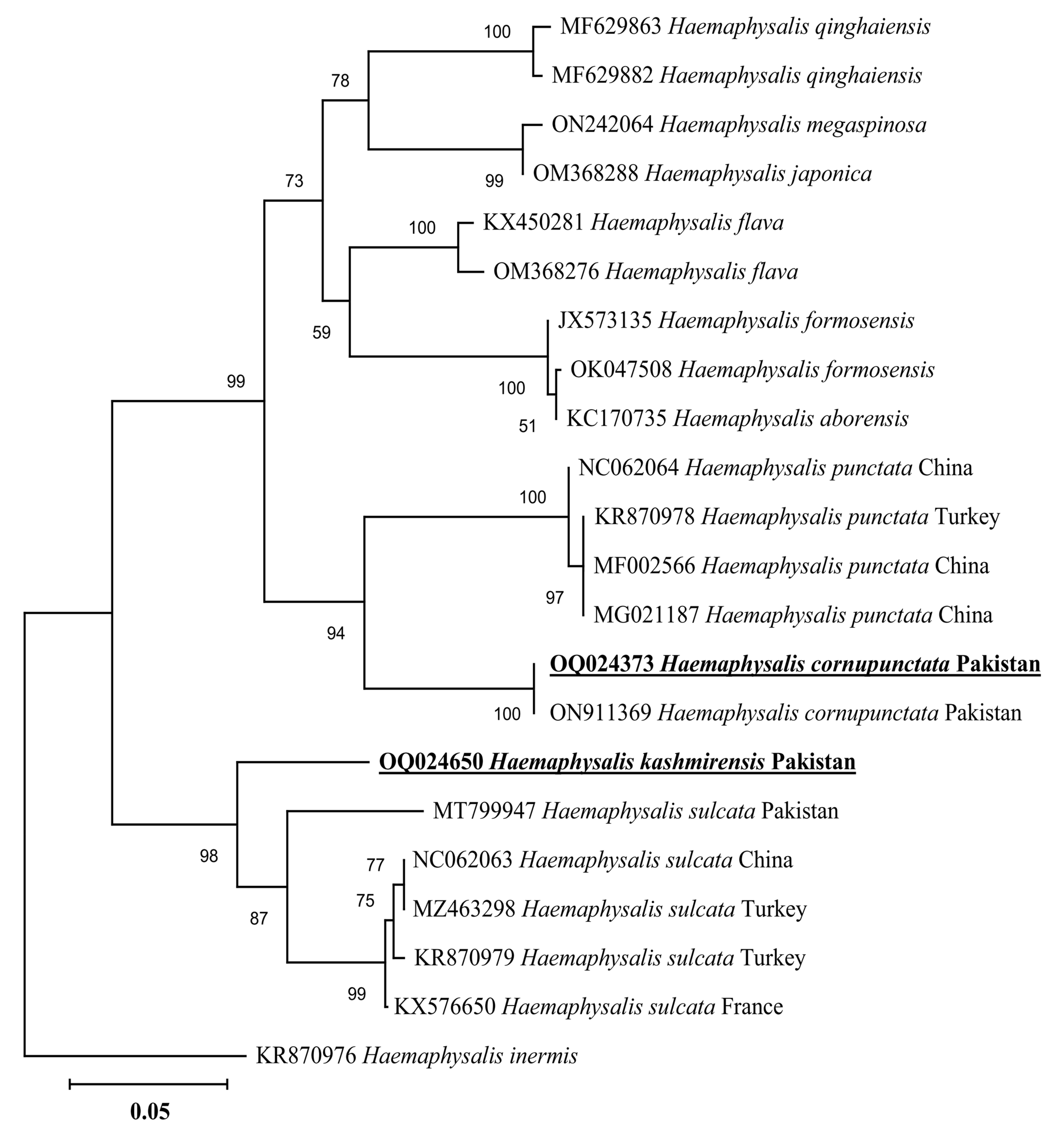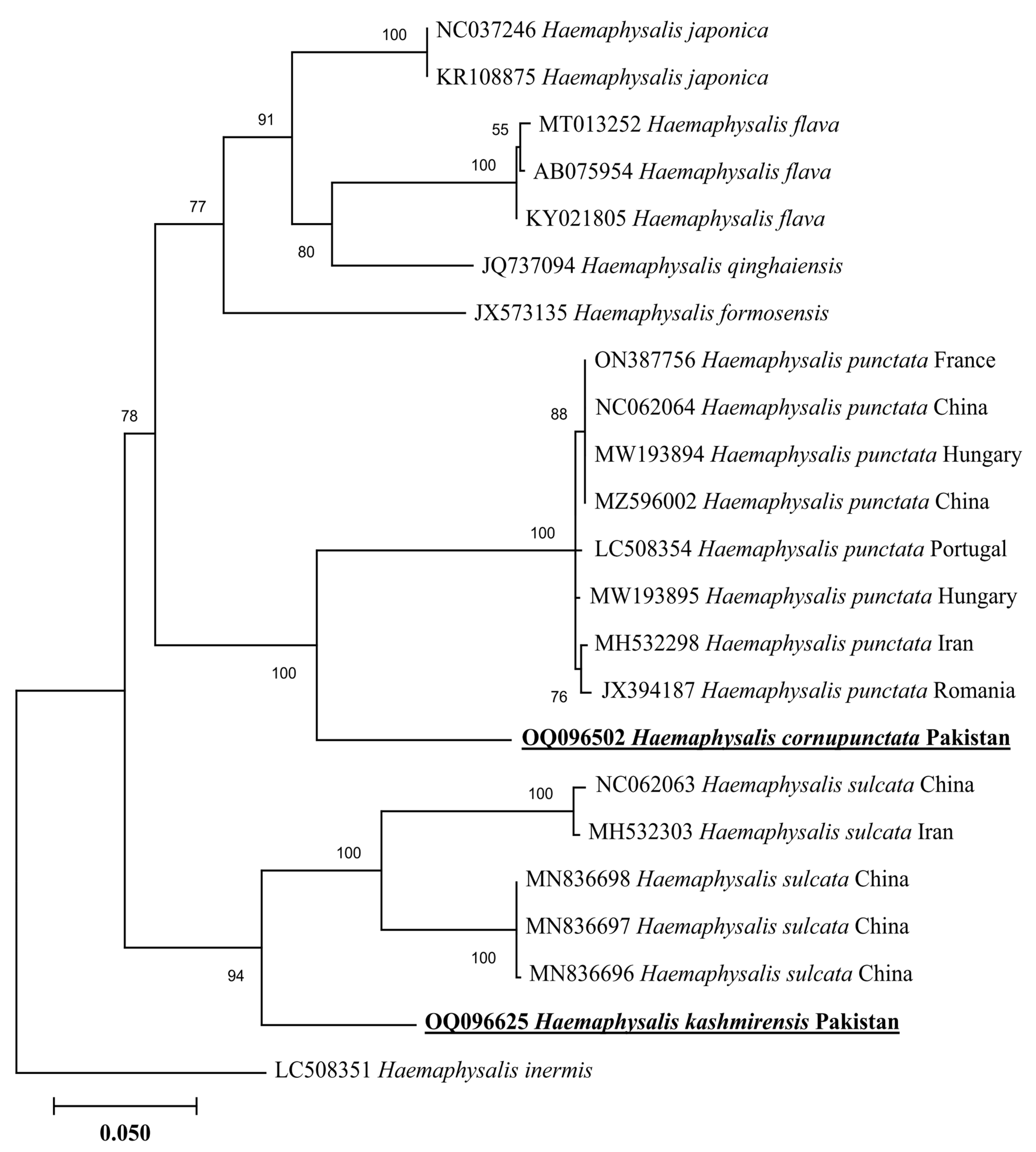Phylogenetic Position of Haemaphysalis kashmirensis and Haemaphysalis cornupunctata, with Notes on Rickettsia spp.
Abstract
1. Introduction
2. Materials and Methods
2.1. Study Sites
2.2. Ethical Approval and Consent
2.3. Tick Collection and Morphological Identification
2.4. Statistical Analyses
2.5. DNA Extraction and PCR Amplification
2.6. Sequencing and Phylogenetic Analysis
3. Results
3.1. Ticks, Hosts, and Seasonal Data
3.2. Molecular Analysis
3.3. Phylogenetic Analysis
4. Discussion
5. Conclusions
Author Contributions
Funding
Institutional Review Board Statement
Informed Consent Statement
Data Availability Statement
Acknowledgments
Conflicts of Interest
References
- Guglielmone, A.A.; Petney, T.N.; Robbins, R.G. Ixodidae (Acari: Ixodoidea): Descriptions and redescriptions of all known species from 1758 to December 31, 2019. Zootaxa 2020, 4871, 1–322. [Google Scholar] [CrossRef] [PubMed]
- Jongejan, F.; Uilenberg, G. The global importance of ticks. Parasitology 2004, 129, S3–S14. [Google Scholar] [CrossRef] [PubMed]
- Apanaskevich, D.A.; Tomlinson, J.A. Description of four new species of Haemaphysalis Koch, 1844 (Acari: Ixodidae) from the H. (Rhipistoma) spinulosa subgroup, parasites of carnivores and rodents in Africa. Syst. Parasitol. 2019, 96, 625–657. [Google Scholar] [CrossRef] [PubMed]
- Guan, G.; Moreau, E.; Liu, J.; Hao, X.; Ma, M.; Luo, J.; Chauvin, A.; Yin, H. Babesia sp. BQ1 (Lintan): Molecular evidence of experimental transmission to sheep by Haemaphysalis qinghaiensis and Haemaphysalis longicornis. Parasitol. Int. 2010, 59, 265–267. [Google Scholar] [CrossRef]
- Jiang, J.; An, H.; Lee, J.S.; O’Guinn, M.L.; Kim, H.C.; Chong, S.T.; Zhang, Y.; Song, D.; Burrus, R.G.; Bao, Y.; et al. Molecular characterization of Haemaphysalis longicornis-borne rickettsiae, Republic of Korea and China. Ticks Tick-Borne Dis. 2018, 9, 1606–1613. [Google Scholar] [CrossRef]
- Lee, J.H.; Park, H.S.; Jung, K.D.; Jang, W.J.; Koh, S.E.; Kang, S.S.; Lee, I.Y.; Lee, W.J.; Kim, B.J.; Kook, Y.H.; et al. Identification of the spotted fever group rickettsiae detected from Haemaphysalis longicornis in Korea. Microbiol. Immunol. 2003, 47, 301–304. [Google Scholar] [CrossRef]
- Cheng, C.; Fu, W.; Ju, W.; Yang, L.; Xu, N.; Wang, Y.M.; Li, H.; Wang, Y.L.; Hu, M.X.; Wen, J.; et al. Diversity of spotted fever group Rickettsia infection in hard ticks from Suifenhe, Chinese–Russian border. Ticks Tick-Borne Dis. 2016, 7, 715–719. [Google Scholar] [CrossRef] [PubMed]
- Noh, Y.; Lee, Y.S.; Kim, H.C.; Chong, S.T.; Klein, T.A.; Jiang, J.; Richards, A.L.; Lee, H.K.; Kim, S.Y. Molecular detection of Rickettsia species in ticks collected from the southwestern provinces of the Republic of Korea. Parasit. Vectors 2017, 10, 1–10. [Google Scholar] [CrossRef]
- Igolkina, Y.; Rar, V.; Vysochina, N.; Ivanov, L.; Tikunov, A.; Pukhovskaya, N.; Epikhina, T.; Golovljova, I.; Tikunova, N. Genetic variability of Rickettsia spp. in Dermacentor and Haemaphysalis ticks from the Russian Far East. Ticks Tick-Borne Dis. 2018, 9, 1594–1603. [Google Scholar] [CrossRef]
- Qin, X.R.; Han, H.J.; Han, F.J.; Zhao, F.M.; Zhang, Z.T.; Xue, Z.F.; Ma, D.Q.; Qi, R.; Zhao, M.; Wang, L.J.; et al. Rickettsia japonica and novel Rickettsia species in ticks, China. Emerg. Infect. Dis. 2019, 25, 992. [Google Scholar] [CrossRef]
- Hoogstraal, H.; Kim, K.C. Tick and mammal coevolution, with emphasis on Haemaphysalis. In Coevolution of Parasitic Arthropods and Mammals; Kim, K.C., Ed.; Wiley International Science: New York, NY, USA, 1985; pp. 505–568. [Google Scholar]
- Hoogstraal, H.; Trapido, H.; Kohls, G.M. Studies on southeast Asian Haemaphysalis ticks (Ixodoidea, Ixodidae). Speciation in the H. (Kaiseriana) obesa group: H. semermis Neumann, H. obesa Larrousse, H. roubaudi Toumanoff, H. montgomeryi Nuttall, and H. hirsuta sp. n. J. Parasitol. 1966, 52, 169–191. [Google Scholar] [CrossRef]
- Dhanda, V.; Kulkarni, S.M. Immature stages of Haemaphysalis cornupunctata Hoogstraal and Varma, 1962 (Acarina: Ixodidae) with new host and locality records, and notes on its ecology. Orient. Insects 1969, 3, 15–21. [Google Scholar] [CrossRef]
- Hoogstraal, H.; Varma, M.G.R. Haemaphysalis cornupunctata sp. n. and H. kashmirensis sp. n. from Kashmir, with Notes on H. sundrai Sharif and H. sewelli Sharif of India and Pakistan (Ixodoidea, Ixodidae). J. Parasitol. 1962, 48, 185–194. [Google Scholar] [CrossRef] [PubMed]
- Karim, S.; Budachetri, K.; Mukherjee, N.; Williams, J.; Kausar, A.; Hassan, M.J.; Adamson, S.; Dowd, S.E.; Apanskevich, D.; Arijo, A.; et al. A study of ticks and tick-borne livestock pathogens in Pakistan. PLoS Negl. Trop. Dis. 2017, 11, e0005681. [Google Scholar] [CrossRef]
- Ali, A.; Numan, M.; Ullah, S.; Khan, M.; Kamran, K. Genetic Characterization of Haemaphysalis (Rhipistoma) indica and Haemaphysalis (Segalia) montgomeryi Ticks (Ixodoidea: Ixodidae). Ticks Tick-Borne Dis. 2022, 14, 102105. [Google Scholar] [CrossRef]
- Alam, S.; Khan, M.; Alouffi, A.; Almutairi, M.M.; Ullah, S.; Numan, M.; Islam, N.; Khan, Z.; Aiman, O.; Safi, S.Z.; et al. Spatio-Temporal Patterns of Ticks and Molecular Survey of Anaplasma marginale, with Notes on Their Phylogeny. Microorganisms 2022, 10, 1663. [Google Scholar] [CrossRef]
- Khan, Z.; Shehla, S.; Alouffi, A.; Obaid, M.K.; Khan, A.Z.; Almutairi, M.M.; Numan, M.; Aiman, O.; Alam, S.; Ullah, S.; et al. Molecular Survey and Genetic Characterization of Anaplasma marginale in Ticks Collected from Livestock Hosts in Pakistan. Animals 2022, 12, 1708. [Google Scholar] [CrossRef]
- Ali, A.; Khan, M.A.; Zahid, H.; Yaseen, P.M.; Qayash Khan, M.; Nawab, J.; Ur Rehman, Z.; Ateeq, M.; Khan, S.; Ibrahim, M. Seasonal dynamics, record of ticks infesting humans, wild and domestic animals and molecular phylogeny of Rhipicephalus microplus in Khyber Pakhtunkhwa Pakistan. Front. Physiol. 2019, 10, 793. [Google Scholar] [CrossRef] [PubMed]
- Ahmad., I.; Ullah, S.; Alouffi, A.; Almutairi, M.M.; Khan, M.; Numan, M.; Safi, S.Z.; Chitimia-Dobler, L.; Tanaka, T.; Ali, A. Description of Male, Redescription of Female, Host Record, and Phylogenetic Position of Haemaphysalis danieli. Pathogens 2022, 11, 1495. [Google Scholar] [CrossRef]
- Hoogstraal, H.; McCarthy, V.C. Hosts and distribution of Haemaphysalis kashmirensis with descriptions of immature stages and definition of the subgenus Herpetobia Canestrini (resurrected). J. Parasitol. 1965, 51, 674–679. [Google Scholar] [CrossRef]
- Sambrook, J.; Fritsch, E.E.; Maniatis, T. Molecular Cloning: A Laboratory Manual, 2nd ed.; Cold Spring Harbor Laboratory Press: New York, NY, USA, 1989. [Google Scholar]
- Folmer, O.; Hoeh, W.R.; Black, M.B.; Vrijenhoek, R.C. Conserved primers for PCR amplification of mitochondrial DNA from different invertebrate phyla. Mol. Marine Biol. Biotechnol. 1994, 3, 294–299. [Google Scholar]
- Mangold, A.J.; Bargues, M.D.; Mas-Coma, S. Mitochondrial 16S rDNA sequences and phylogenetic relationships of species of Rhipicephalus and other tick genera among Metastriata (Acari: Ixodidae). Parasitol. Res. 1998, 84, 478–484. [Google Scholar] [CrossRef]
- Labruna, M.B.; Whitworth, T.; Bouyer, D.H.; McBride, J.; Camargo, L.M.A.; Camargo, E.P.; Popov, V.; Walker, D.H. Rickettsia bellii and Rickettsia amblyommii in Amblyomma ticks from the state of Rondônia, Western Amazon, Brazil. J. Med. Entomol. 2004, 41, 1073–1081. [Google Scholar] [CrossRef] [PubMed]
- Roux, V.; Fournier, P.E.; Raoult, D. Differentiation of spotted fever group rickettsiae by sequencing and analysis of restriction fragment length polymorphism of PCR-amplified DNA of the gene encoding the protein rOmpA. J. Clin. Microbiol. 1996, 34, 2058–2065. [Google Scholar] [CrossRef] [PubMed]
- Roux, V.; Raoult, D. Phylogenetic analysis of members of the genus Rickettsia using the gene encoding the outer-membrane protein rOmpB (ompB). Int. J. Syst. Evol. Microbiol. 2000, 50, 1449–1455. [Google Scholar] [CrossRef] [PubMed]
- Altschul, S.F.; Gish, W.; Miller, W.; Myers, E.W.; Lipman, D.J. Basic local alignment search tool. J. mol. Biol. 1990, 215, 403–410. [Google Scholar] [CrossRef]
- Hall, T.; Biosciences, I.; Carlsbad, C.J.G.B.B. BioEdit: An important software for molecular biology. GERF Bull. Biosci. 2011, 2, 60–61. [Google Scholar]
- Thompson, J.D.; Higgins, D.G.; Gibson, T.J. CLUSTAL W: Improving the sensitivity of progressive multiple sequence alignment through sequence weighting, position-specific gap penalties and weight matrix choice. Nucleic Acids Res. 1994, 22, 4673–4680. [Google Scholar] [CrossRef] [PubMed]
- Kumar, S.; Stecher, G.; Li, M.; Knyaz, C.; Tamura, K. MEGA X: Molecular evolutionary genetics analysis across computing platforms. Mol. Biol. Evol. 2018, 35, 1547. [Google Scholar] [CrossRef]
- Edgar, R.C. MUSCLE: Multiple sequence alignment with high accuracy and high throughput. Nucleic Acids Res. 2004, 32, 1792–1797. [Google Scholar] [CrossRef]
- Aiman, O.; Ullah, S.; Chitimia-Dobler, L.; Nijhof, A.M.; Ali, A. First report of Nosomma monstrosum ticks infesting Asian water buffaloes (Bubalus bubalis) in Pakistan. Ticks Tick-Borne Dis. 2022, 13, 101899. [Google Scholar] [CrossRef] [PubMed]
- Hoogstraal, H. Biological patterns in the Afghanistan tick fauna. In Proceedings of the 3rd International Congress of Acarology; Springer: Dordrecht, The Netherlands, 1973; pp. 511–514. [Google Scholar]
- Zhao, L.; Li, J.; Cui, X.; Jia, N.; Wei, J.; Xia, L.; Wang, H.; Zhou, Y.; Wang, Q.; Liu, X.; et al. Distribution of Haemaphysalis longicornis and associated pathogens: Analysis of pooled data from a China field survey and global published data. Lancet Planet. Health 2020, 4, e320–e329. [Google Scholar] [CrossRef] [PubMed]
- Ogata, H.; La Scola, B.; Audic, S.; Renesto, P.; Blanc, G.; Robert, C.; Fournier, P.E.; Claverie, J.M.; Raoult, D. Genome sequence of Rickettsia bellii illuminates the role of amoebae in gene exchanges between intracellular pathogens. PLoS Genet. 2006, 2, e76. [Google Scholar] [CrossRef]
- Thu, M.J.; Qiu, Y.; Matsuno, K.; Kajihara, M.; Mori-Kajihara, A.; Omori, R.; Monma, N.; Chiba, K.; Seto, J.; Gokuden, M.; et al. Diversity of spotted fever group rickettsiae and their association with host ticks in Japan. Sci. Rep. 2019, 9, 1–10. [Google Scholar] [CrossRef] [PubMed]
- Reeves, W.K.; Mans, B.J.; Durden, L.A.; Miller, M.M.; Gratton, E.M.; Laverty, T.M. Rickettsia hoogstraalii and a Rickettsiella from the Bat tick Argas transgariepinus, in Namibia. J. Parasitol. 2020, 106, 663–669. [Google Scholar] [CrossRef] [PubMed]
- Chochlakis, D.; Ioannou, I.; Sandalakis, V.; Dimitriou, T.; Kassinis, N.; Papadopoulos, B.; Tselentis, Y.; Psaroulaki, A. Spotted fever group Rickettsiae in ticks in Cyprus. Microb. Ecol. 2012, 63, 314–323. [Google Scholar] [CrossRef]
- Orkun, Ö.; Karaer, Z.; Çakmak, A.; Nalbantoğlu, S. Spotted fever group rickettsiae in ticks in Turkey. Ticks Tick-Borne Dis. 2014, 5, 213–218. [Google Scholar] [CrossRef] [PubMed]
- Chisu, V.; Leulmi, H.; Masala, G.; Piredda, M.; Foxi, C.; Parola, P. Detection of Rickettsia hoogstraalii, Rickettsia helvetica, Rickettsia massiliae, Rickettsia slovaca and Rickettsia aeschlimannii in ticks from Sardinia, Italy. Ticks Tick-Borne Dis. 2017, 8, 347–352. [Google Scholar] [CrossRef]
- Parola, P.; Paddock, C.D.; Socolovschi, C.; Labruna, M.B.; Mediannikov, O.; Kernif, T.; Abdad, M.Y.; Stenos, J.; Bitam, I.; Fournier, P.E.; et al. Update on tick-borne rickettsioses around the world: A geographic approach. Clin. Microbiol. Rev. 2013, 26, 657–702. [Google Scholar] [CrossRef]
- Norris, D.E.; Klompen, J.S.H.; Black, W.C. Comparison of the mitochondrial 12S and 16S ribosomal DNA genes in resolving phylogenetic relationships among hard ticks (Acari: Ixodidae). Ann. Entomolo. Soc. Am. 1999, 92, 117–129. [Google Scholar] [CrossRef]
- Latrofa, M.S.; Dantas-Torres, F.; Annoscia, G.; Cantacessi, C.; Otranto, D. Comparative analyses of mitochondrial and nuclear genetic markers for the molecular identification of Rhipicephalus spp. Infect. Genet. Evol. 2013, 20, 422–427. [Google Scholar] [CrossRef] [PubMed]
- Numan, M.; Islam, N.; Adnan, M.; Safi, S.Z.; Chitimia-Dobler, L.; Labruna, M.B.; Ali, A. First genetic report of Ixodes kashmiricus and associated Rickettsia sp. Parasit. Vectors 2022, 15, 1–12. [Google Scholar] [CrossRef]
- Ali, A.; Numan, M.; Khan, M.; Aiman, O.; Muñoz-Leal, S.; Chitimia-Dobler, L.; Labruna, M.B.; Nijhof, A. Ornithodoros (Pavlovskyella) ticks associated with a Rickettsia sp. in Pakistan. Parasit. Vectors 2022, 15, 1–13. [Google Scholar] [CrossRef] [PubMed]
- Ali, A.; Zahid, H.; Zeb, I.; Tufail, M.; Khan, S.; Haroon, M.; Bilal, M.; Hussain, M.; Alouffi, A.S.; Muñoz-Leal, S.; et al. Risk factors associated with tick infestations on equids in Khyber Pakhtunkhwa, Pakistan, with notes on Rickettsia massiliae detection. Parasit. Vectors 2021, 14, 1–12. [Google Scholar] [CrossRef]
- Zahid, H.; Muñoz-Leal, S.; Khan, M.Q.; Alouffi, A.S.; Labruna, M.B.; Ali, A. Life cycle and genetic identification of Argas persicus infesting domestic fowl in Khyber Pakhtunkhwa, Pakistan. Front. Vet. Sci. 2021, 8, 302. [Google Scholar] [CrossRef]
- Khan, M.; Islam, N.; Khan, A.; Islam, Z.U.; Muñoz-Leal, S.; Labruna, M.B.; Ali, A. New records of Amblyomma gervaisi from Pakistan, with detection of a reptile-associated Borrelia sp. Ticks Tick-Borne Dis. 2022, 13, 102047. [Google Scholar] [CrossRef] [PubMed]







| Organisms/Genes | Sequence (5′-3′) | Amplicons Size | Annealing Temperatures | References |
|---|---|---|---|---|
| Ticks/cox | HCO2198: TAAACTTCAGGGTGACCAAAAAATCA | 710 bp | 49 °C | [23] |
| LCO1490: GGTCAACAAATCATAAAGATATTGG | ||||
| Ticks/16S rDNA | 16S+1: CCGGTCTGAACTCAGATCAAG T | 460 bp | 54 °C | [24] |
| 16S-1: GCTCAATGATTTTTTAAATTGCTGT | ||||
| Rickettsia/gltA | CS-78: GCAAGTATCGGTGAGGATGTAAT | 401 bp | 56 °C | [25] |
| CS-323: GCTTCCTAAAATTCAATAAATCAGGAT | ||||
| Rickettsia/ompA | Rr190.70: ATGGCGAATATTTCTCCAAAA | 532 bp | 55 °C | [26] |
| Rr190.701: GTTCCGTTAATGGCAGCATCT | ||||
| Rickettsia/ompB | 120-M59: CCGCAGGGTTGGTAACTGC | 862 bp | 50 °C | [27] |
| 120-807: CCTTTTAGATTACCGCCTAA |
| Districts | Host | Species | Life Stages | Total | Tick Subjected to PCR | PCR for Rickettsia spp. | ||||||||||
|---|---|---|---|---|---|---|---|---|---|---|---|---|---|---|---|---|
| Common Name | Number (Infested/ Total) | Females | Males | Nymphs | Rickettsia sp. | R. hoogstraalii | ||||||||||
| ompA | ompB | gltA | Total Positive Samples (Infection Rates) | ompA | ompB | gltA | Total Positive Samples (Infection Rates) | |||||||||
| Bajaur | Goats, Sheep | 5/8 | H. cornupunctata | 22 | 14 | 5 | 41 | 3M, 3F, 3N | 0 | 0 | 0 | 0 | 0 | 0 | 0 | 0 |
| Goats, Sheep | 4/7 | H. kashmirensis | 18 | 12 | 3 | 33 | 3M, 3F, 3N | 2F | 0 | 2N | 4 (44.44%) | 0 | 0 | 0 | 0 | |
| Goats, Sheep | 6/9 | H. montgomeryi | 25 | 28 | 6 | 59 | 3M, 3F, 3N | 0 | 0 | 0 | 0 | 0 | 0 | 0 | 0 | |
| Dir Lower | Goats, Sheep | 6/8 | H. cornupunctata | 35 | 26 | 5 | 66 | 3M, 3F, 3N | 0 | 0 | 0 | 0 | 0 | 0 | 0 | 0 |
| Goats, Sheep | 5/7 | H. kashmirensis | 28 | 14 | 4 | 46 | 3M, 3F, 3N | 0 | 0 | 2N | 2 (22.23%) | 0 | 0 | 0 | 0 | |
| Goats, Sheep | 12/16 | H. montgomeryi | 81 | 47 | 11 | 139 | 3M, 3F, 3N | 0 | 0 | 0 | 0 | 0 | 0 | 2F, 2M | 4 (44.44%) | |
| Dir Upper | Goats, Sheep | 12/15 | H. cornupunctata | 74 | 35 | 14 | 123 | 3M, 3F, 3N | 0 | 0 | 0 | 0 | 0 | 0 | 0 | 0 |
| Goats, Sheep | 11/15 | H. kashmirensis | 45 | 29 | 12 | 86 | 3M, 3F, 3N | 2F, 2N | 2N | 0 | 6 (66.66%) | 0 | 0 | 0 | 0 | |
| Goats, Sheep | 12/16 | H. montgomeryi | 77 | 61 | 14 | 152 | 3M, 3F, 3N | 0 | 0 | 0 | 0 | 0 | 0 | 2F, 2N | 4 (44.44%) | |
| Swat | Goats, Sheep | 4/6 | H. cornupunctata | 14 | 11 | 3 | 28 | 3M, 3F, 3N | 0 | 0 | 0 | 0 | 0 | 0 | 0 | 0 |
| Goats, Sheep | 4/6 | H. kashmirensis | 11 | 12 | 3 | 26 | 3M, 3F, 3N | 2M | 3F | 0 | 5 (55.56%) | 0 | 0 | 0 | 0 | |
| Goats, Sheep | 5/7 | H. montgomeryi | 19 | 12 | 4 | 35 | 3M, 3F, 3N | 0 | 0 | 0 | 0 | 0 | 0 | 0 | 0 | |
| Total | 86/120 (71.3%) | 449 (53.8%) | 301 (36%) | 84 (10%) | 834 | 108 | 4F, 2M, 2N | 2N, 3F | 4N | 17 (15.74%) | 0 | 0 | 4F, 2M, 2N | 6 (5.56%) | ||
Disclaimer/Publisher’s Note: The statements, opinions and data contained in all publications are solely those of the individual author(s) and contributor(s) and not of MDPI and/or the editor(s). MDPI and/or the editor(s) disclaim responsibility for any injury to people or property resulting from any ideas, methods, instructions or products referred to in the content. |
© 2023 by the authors. Licensee MDPI, Basel, Switzerland. This article is an open access article distributed under the terms and conditions of the Creative Commons Attribution (CC BY) license (https://creativecommons.org/licenses/by/4.0/).
Share and Cite
Khan, S.M.; Khan, M.; Alouffi, A.; Almutairi, M.M.; Numan, M.; Ullah, S.; Obaid, M.K.; Islam, Z.U.; Ahmed, H.; Tanaka, T.; et al. Phylogenetic Position of Haemaphysalis kashmirensis and Haemaphysalis cornupunctata, with Notes on Rickettsia spp. Genes 2023, 14, 360. https://doi.org/10.3390/genes14020360
Khan SM, Khan M, Alouffi A, Almutairi MM, Numan M, Ullah S, Obaid MK, Islam ZU, Ahmed H, Tanaka T, et al. Phylogenetic Position of Haemaphysalis kashmirensis and Haemaphysalis cornupunctata, with Notes on Rickettsia spp. Genes. 2023; 14(2):360. https://doi.org/10.3390/genes14020360
Chicago/Turabian StyleKhan, Shah Masood, Mehran Khan, Abdulaziz Alouffi, Mashal M. Almutairi, Muhmmad Numan, Shafi Ullah, Muhammad Kashif Obaid, Zia Ul Islam, Haroon Ahmed, Tetsuya Tanaka, and et al. 2023. "Phylogenetic Position of Haemaphysalis kashmirensis and Haemaphysalis cornupunctata, with Notes on Rickettsia spp." Genes 14, no. 2: 360. https://doi.org/10.3390/genes14020360
APA StyleKhan, S. M., Khan, M., Alouffi, A., Almutairi, M. M., Numan, M., Ullah, S., Obaid, M. K., Islam, Z. U., Ahmed, H., Tanaka, T., & Ali, A. (2023). Phylogenetic Position of Haemaphysalis kashmirensis and Haemaphysalis cornupunctata, with Notes on Rickettsia spp. Genes, 14(2), 360. https://doi.org/10.3390/genes14020360










